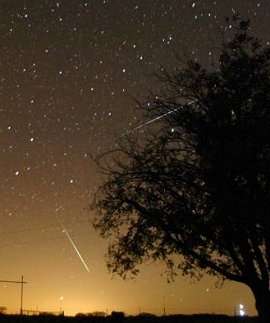The 2006 Geminid Meteor Shower

The best meteor shower of the year peaks this week on Dec. 13th and 14th.
"It's the Geminid meteor shower," says Bill Cooke of NASA's Meteoroid Environment Office in Huntsville, Alabama. "Start watching on Wednesday evening, Dec. 13th, around 9 p.m. local time," he advises. "The display will start small but grow in intensity as the night wears on. By Thursday morning, Dec. 14th, people in dark, rural areas could see one or two meteors every minute."
The source of the Geminids is a mysterious object named 3200 Phaethon. "No one can decide what it is," says Cooke.
The mystery, properly told, begins in the 19th century: Before the mid-1800s there were no Geminids, or at least not enough to attract attention. The first Geminids appeared suddenly in 1862, surprising onlookers who saw dozens of meteors shoot out of the constellation Gemini. (That's how the shower gets its name, the Geminids.)
Astronomers immediately began looking for a comet. Meteor showers result from debris that boils off a comet when it passes close to the Sun. When Earth passes through the debris, we see a meteor shower.
For more than a hundred years astronomers searched in vain for the parent comet. Finally, in 1983, NASA's Infra-Red Astronomy Satellite (IRAS) spotted something. It was several kilometers wide and moved in about the same orbit as the Geminid meteoroids. Scientists named it 3200 Phaethon.
Just one problem: Meteor showers are supposed to come from comets, but 3200 Phaethon seems to be an asteroid. It is rocky (not icy, like a comet) and has no obvious tail. Officially, 3200 Phaethon is catalogued as a "PHA"—a potentially hazardous asteroid whose path misses Earth's orbit by only 2 million miles.
If 3200 Phaethon is truly an asteroid, with no tail, how did it produce the Geminids? "Maybe it bumped up against another asteroid," offers Cooke. "A collision could have created a cloud of dust and rock that follows Phaethon around in its orbit."
This jibes with studies of Geminid fireballs. Some astronomers have studied the brightest Geminid meteors and concluded that the underlying debris must be rocky. Density estimates range from 1 to 3 g/cm3. That's much denser than flakes of comet dust (0.3 g/cm3), but close to the density of rock (3 g/cm3).
So, are the Geminids an "asteroid shower"?
Cooke isn't convinced. 3200 Phaethon might be a comet after all--"an extinct comet," he says. The object's orbit carries it even closer to the Sun than Mercury. Extreme solar heat could've boiled away all of Phaethon's ice long ago, leaving behind this rocky skeleton "that merely looks like an asteroid."
In short, no one knows. It's a mystery to savor under the stars—the shooting stars—this Thursday morning.
A note about time: All times in this story are local to the reader. So "Thursday morning" means Thursday morning wherever you happen to live.
Source: by Dr. Tony Phillips, Science@NASA





















